RENAULT KANGOO 2018 Owners Manual
Manufacturer: RENAULT, Model Year: 2018, Model line: KANGOO, Model: RENAULT KANGOO 2018Pages: 264, PDF Size: 7.09 MB
Page 211 of 264
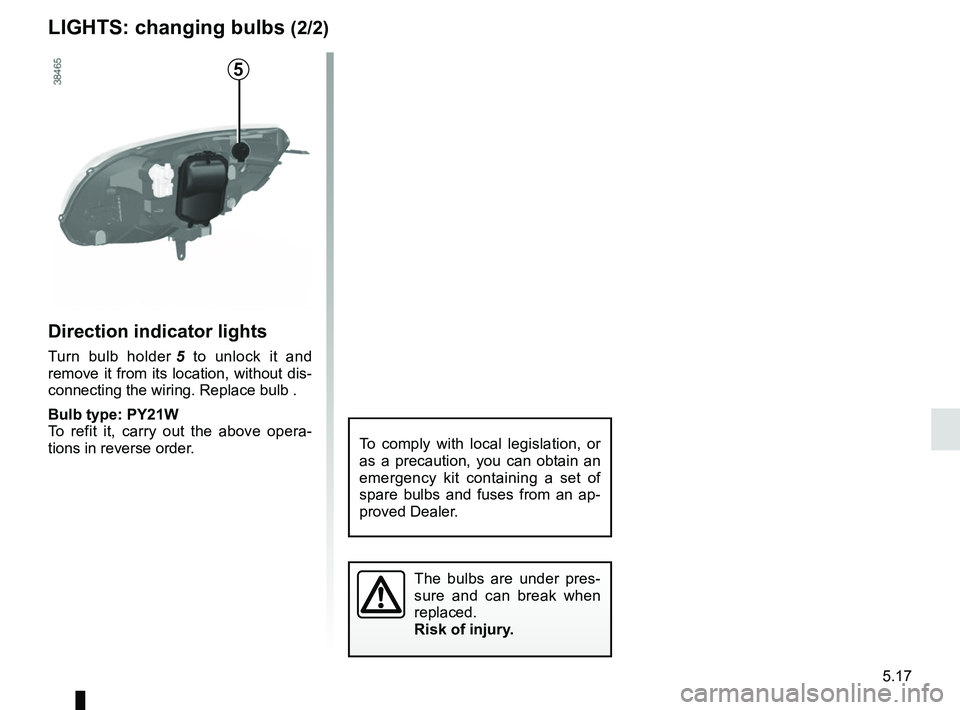
5.17
Direction indicator lights
Turn bulb holder 5 to unlock it and
remove it from its location, without dis-
connecting the wiring. Replace bulb .
Bulb type: PY21W
To refit it, carry out the above opera-
tions in reverse order.
The bulbs are under pres-
sure and can break when
replaced.
Risk of injury.
LIGHTS: changing bulbs (2/2)
To comply with local legislation, or
as a precaution, you can obtain an
emergency kit containing a set of
spare bulbs and fuses from an ap-
proved Dealer.
5
Page 212 of 264
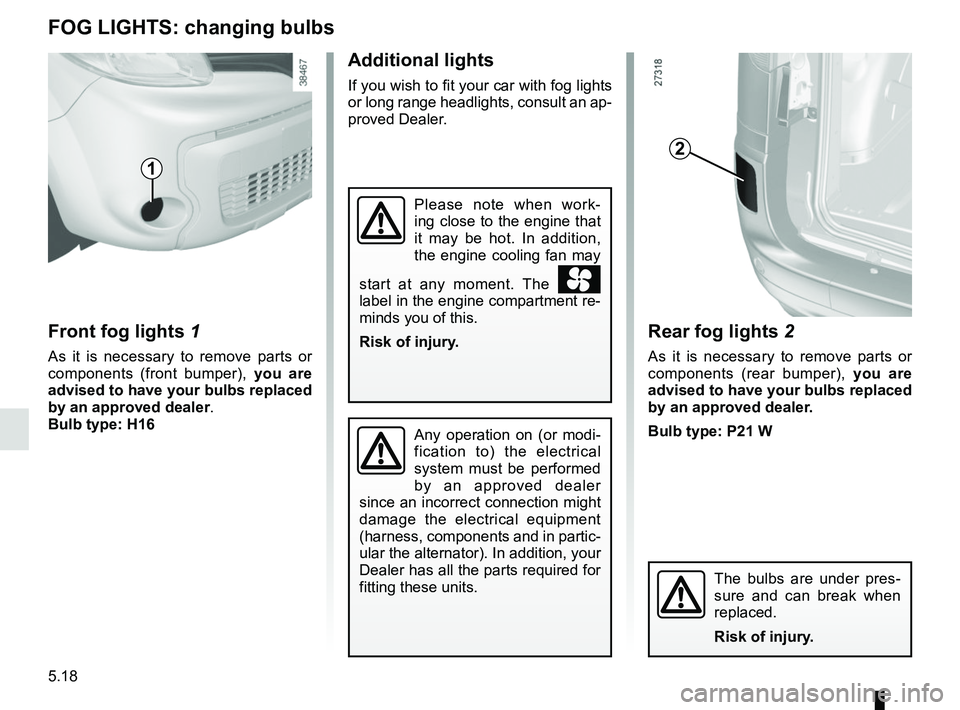
5.18
Front fog lights 1
As it is necessary to remove parts or
components (front bumper), you are
advised to have your bulbs replaced
by an approved dealer.
Bulb type: H16
Additional lights
If you wish to fit your car with fog lights
or long range headlights, consult an ap-
proved Dealer.
FOG LIGHTS: changing bulbs
1
Any operation on (or modi-
fication to) the electrical
system must be performed
by an approved dealer
since an incorrect connection might
damage the electrical equipment
(harness, components and in partic-
ular the alternator). In addition, your
Dealer has all the parts required for
fitting these units.
Rear fog lights 2
As it is necessary to remove parts or
components (rear bumper), you are
advised to have your bulbs replaced
by an approved dealer.
Bulb type: P21 W
2
The bulbs are under pres-
sure and can break when
replaced.
Risk of injury.
Please note when work-
ing close to the engine that
it may be hot. In addition,
the engine cooling fan may
start at any moment. The
label in the engine compartment re-
minds you of this.
Risk of injury.
Page 213 of 264

5.19
The bulbs are under pres-
sure and can break when
replaced.
Risk of injury.
Bulb type
4 Indicator
Pear-shaped, bayonet type bulb P
Y21W.
5 Side and brake light
Pear-shaped, bayonet type bulb
with two filaments P 21/5W.
6 Reversing light
Pear-shaped, bayonet type bulb P
21W.Rear lights
Depending on the vehicle, open the
hinged doors or the tailgate.
Undo bolts 1 using a Torx tool.
Unclip the lower section, then the upper
section of the light by pulling it towards
you.
Pull tabs 2 to unclip bulb holders 3.
Replace the bulb, then proceed in the
reverse order to refit the bulb.
REAR LIGHTS: changing bulbs (1/3)
31
2
2
5
4
6
Page 214 of 264
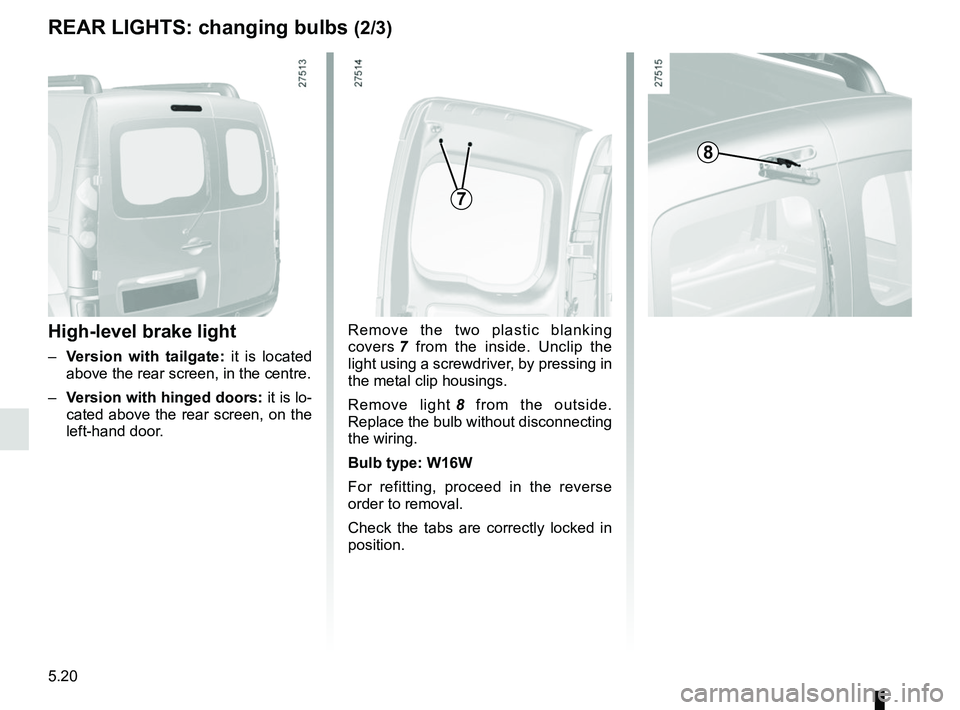
5.20
REAR LIGHTS: changing bulbs (2/3)
High-level brake light
– Version with tailgate: it is located
above the rear screen, in the centre.
– Version with hinged doors: it is lo-
cated above the rear screen, on the
left-hand door. Remove the two plastic blanking
covers 7
from the inside. Unclip the
light using a screwdriver, by pressing in
the metal clip housings.
Remove light 8 from the outside.
Replace the bulb without disconnecting
the wiring.
Bulb type: W16W
For refitting, proceed in the reverse
order to removal.
Check the tabs are correctly locked in
position.
7
8
Page 215 of 264
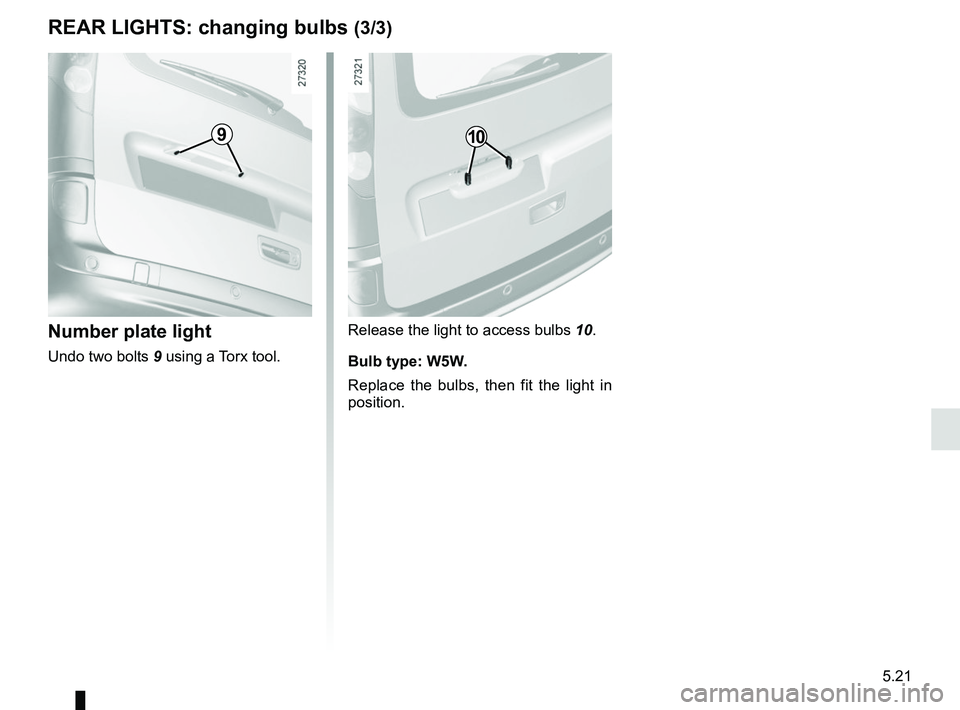
5.21
REAR LIGHTS: changing bulbs (3/3)
Release the light to access bulbs 10.
Bulb type: W5W.
Replace the bulbs, then fit the light in
position.Number plate light
Undo two bolts 9 using a Torx tool.
109
Page 216 of 264
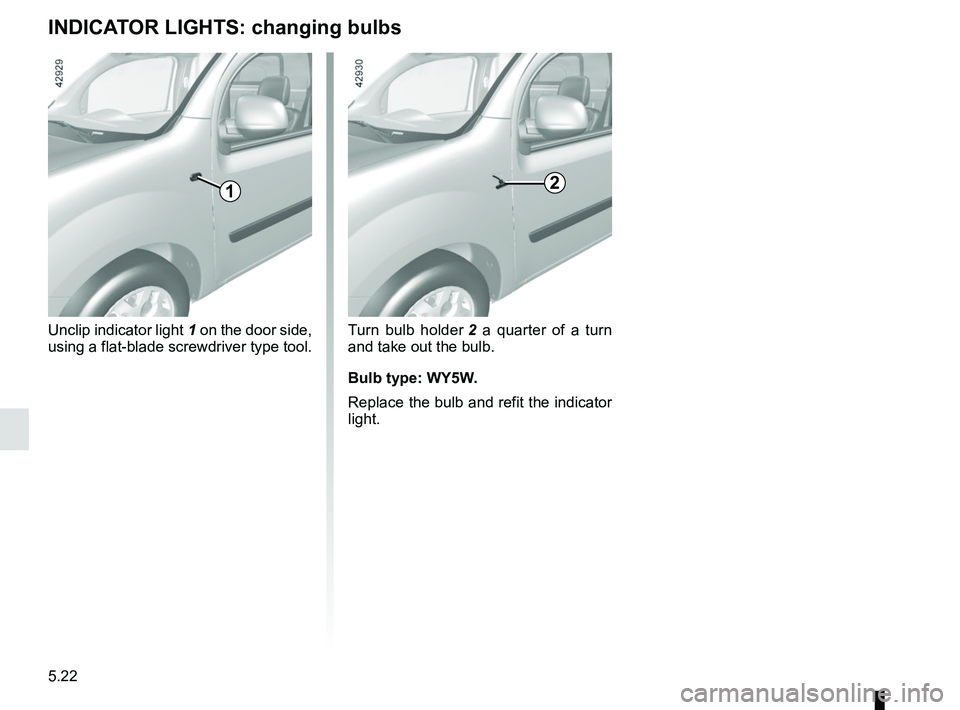
5.22
Turn bulb holder 2 a quarter of a turn
and take out the bulb.
Bulb type: WY5W.
Replace the bulb and refit the indicator
light.
Unclip indicator light
1 on the door side,
using a flat-blade screwdriver type tool.
INDICATOR LIGHTS: changing bulbs
12
Page 217 of 264
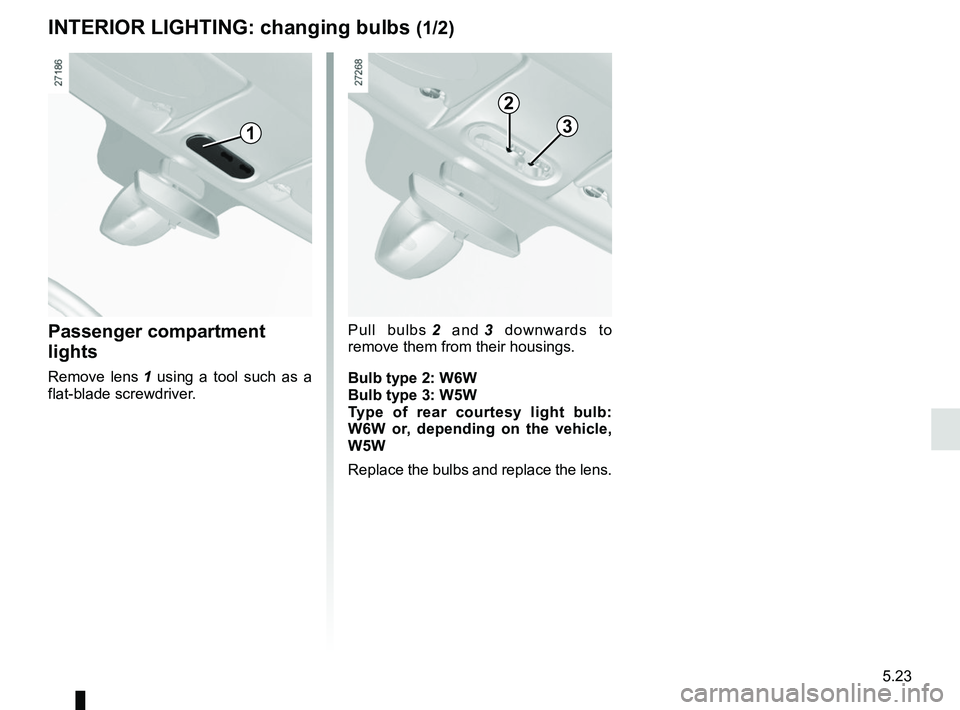
5.23
Passenger compartment
lights
Remove lens 1 using a tool such as a
flat-blade screwdriver.
INTERIOR LIGHTING: changing bulbs (1/2)
1
Pull bulbs 2 and 3 downwards to
remove them from their housings.
Bulb type 2: W6W
Bulb type 3: W5W Type of rear courtesy light bulb:
W6W or, depending on the vehicle,
W5W
Replace the bulbs and replace the lens.
2
3
Page 218 of 264
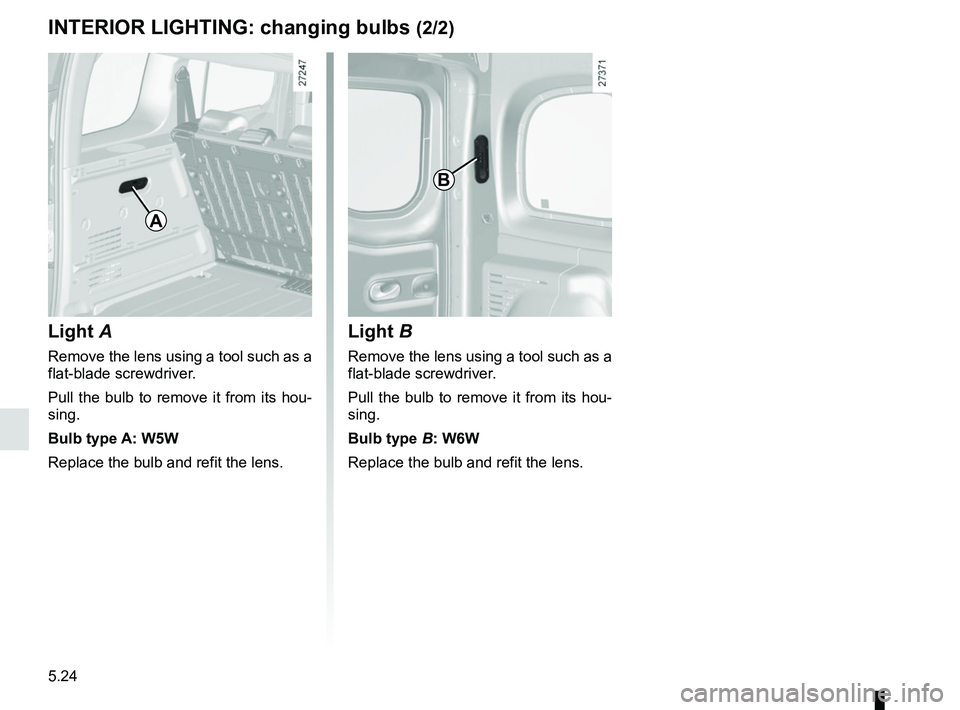
5.24
INTERIOR LIGHTING: changing bulbs (2/2)
Light A
Remove the lens using a tool such as a
flat-blade screwdriver.
Pull the bulb to remove it from its hou-
sing.
Bulb type A: W5W
Replace the bulb and refit the lens.
Light B
Remove the lens using a tool such as a
flat-blade screwdriver.
Pull the bulb to remove it from its hou-
sing.
Bulb type B: W6W
Replace the bulb and refit the lens.
A
B
Page 219 of 264

5.25
BATTERY: troubleshooting (1/2)
Handle the battery with care
as it contains sulphuric acid,
which must not come into
contact with eyes or skin. If
it does, wash the affected area with
plenty of cold water.
Ensure that naked flames, red hot
objects and sparks do not come into
contact with the battery as there is a
risk of explosion.
To avoid all risk of sparks:
– Ensure that any consumers (cour- tesy lights, etc.) are switched off
before disconnecting or reconnect-
ing the battery.
– When charging, stop the charger before connecting or disconnecting
the battery.
– Do not place metal objects on the battery to avoid creating a short cir-
cuit between the terminals.
– Always wait at least twenty seconds after the engine has been switched
off before disconnecting a battery.
– Make sure that you reconnect the battery terminals after refitting.
Before performing any
action in the engine com-
partment, the ignition must
be switched off (please see
the information on “Starting, stop-
ping the engine” in Section 2).
Connecting a battery charger
The battery charger must be com-
patible with a battery with nominal
voltage of 12 volts.
Switch the engine off and then discon-
nect both battery leads starting with
the negative terminal.
Do not disconnect the battery when the
engine is running. Follow the instruc-
tions given by the manufacturer of
the battery charger you are using.
Please note when work-
ing close to the engine that
it may be hot. In addition,
the engine cooling fan may
start at any moment. The
warning light in the engine compart-
ment reminds you of this.
Risk of injury.
Page 220 of 264
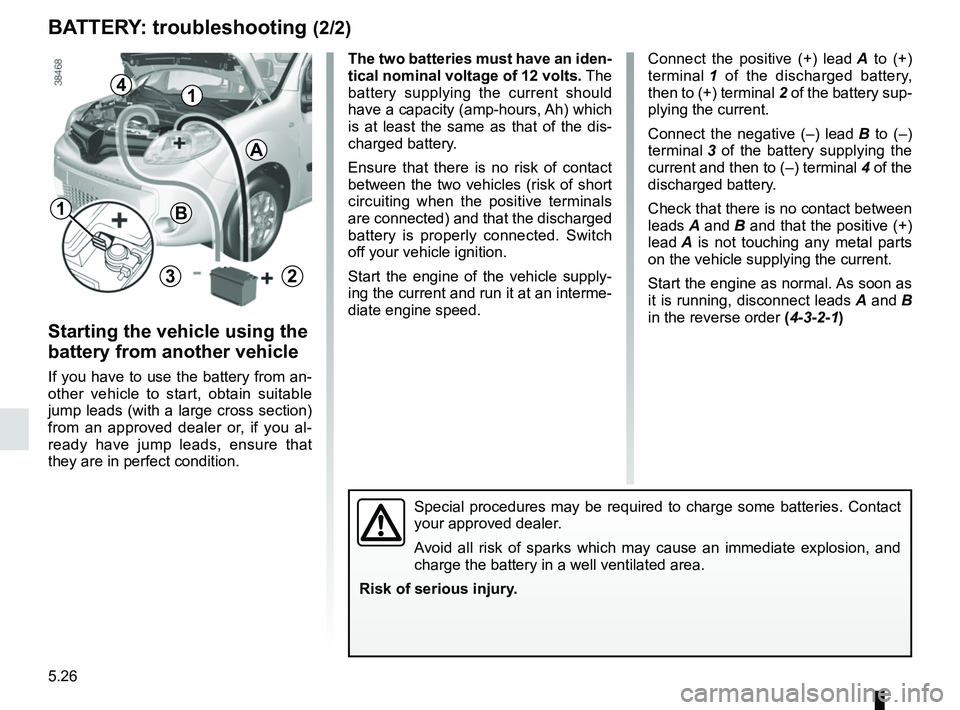
5.26
1
A
2
4
B
3
BATTERY: troubleshooting (2/2)
Connect the positive (+) lead A to (+)
terminal 1 of the discharged battery,
then to (+) terminal 2 of the battery sup-
plying the current.
Connect the negative (–) lead B to (–)
terminal 3 of the battery supplying the
current and then to (–) terminal 4 of the
discharged battery.
Check that there is no contact between
leads A and B and that the positive (+)
lead A is not touching any metal parts
on the vehicle supplying the current.
Start the engine as normal. As soon as
it is running, disconnect leads A and B
in the reverse order (4-3-2-1)
The two batteries must have an iden-
tical nominal voltage of 12 volts.
The
battery supplying the current should
have a capacity (amp-hours, Ah) which
is at least the same as that of the dis-
charged battery.
Ensure that there is no risk of contact
between the two vehicles (risk of short
circuiting when the positive terminals
are connected) and that the discharged
battery is properly connected. Switch
off your vehicle ignition.
Start the engine of the vehicle supply-
ing the current and run it at an interme-
diate engine speed.
Special procedures may be required to charge some batteries. Contact
your approved dealer.
Avoid all risk of sparks which may cause an immediate explosion, and
charge the battery in a well ventilated area.
Risk of serious injury.
1
Starting the vehicle using the
battery from another vehicle
If you have to use the battery from an-
other vehicle to start, obtain suitable
jump leads (with a large cross section)
from an approved dealer or, if you al-
ready have jump leads, ensure that
they are in perfect condition.